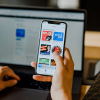 Feature Image by Paul Hanaoka
Feature Image by Paul Hanaoka
There’s only so much you can do when you’re staying at home. So if you’ve been finding yourself glued to your phone more than usual, no one can blame you. But since many of us are spending more time looking at screens these days, it’s important to be extra mindful about protecting our eyes.
As Joseph J. Pizzimenti, O.D., FAAO and Medical Advisor for EyePromise, tells FabFitFun, “Any number of symptoms can result from prolonged screen time: tired eyes, poor focus while reading, dry eyes, heavy lids, blurry vision, and neck strain. These symptoms are associated with computer vision syndrome, which is caused by the strain on the eyes after prolonged use of a digital device. In addition, extended screen time, especially at night, may result in sleep disturbances.”
Since we’re likely going to be using our phones more often over the next few weeks, here are some must-know tips to help you give your eyes a break.
Follow the 20-20-20 rule
Every 20 minutes, take 20 seconds to look at something at least 20 feet away from you. It’s even better if you get up from wherever you’re sitting and stretch or get a drink of water. As Dr. Jenna Zigler, optometrist and “SeeOO” at Eye Love, tells FabFitFun, “This gives the eyes time to rest and refocus at distance, leaving you with less eyestrain at the end of the day.”
Switch your phone display to grayscale
Simply changing the color on your screen can make your phone “a lot less interesting” and easier on the eyes, optometrist Dr. Leigh Plowman, tells FabFitFun. If you have an iPhone, you can easily switch the display to grayscale by going to Settings > Accessibility > Display Accommodations > Color Filters > Grayscale.
Reduce your phone notifications
Even if you have the intention of putting your phone down for a while, that can easily be ruined by the sound of a notification. The number of minutes you’re looking at your screen can really add up. So Dr. Plowman suggests going through your apps and seeing how many notifications you can turn off. Try to keep it to the bare minimum in order to reduce the temptation to stay on your phone.
Blink more
When you’re spending more time on your phone, it’s important to remind yourself to blink more frequently. According to Dr. Brad Brocwell, O.D., VP of Clinical Operations for Now Optics, we tend to blink less when we’re on our phones, causing an increase in that “sandy, gritty feeling” associated with dry eyes. “Blinking more frequently will help keep the eyes lubricated and the use of an over-the-counter non preservative artificial tear can also help reduce the dry eye sensation some experience with increased screen time,” Dr. Brocwell says.
Limit phone usage one to two hours before bedtime
According to Dr. Brocwell, the blue light emitted from your phone can disrupt your circadian rhythm, which is your body’s sleep and wake cycle. When you have too much blue light exposure before bed, it can make it much more difficult to fall asleep. So try and limit using your devices at least a couple of hours before bedtime and using the nighttime setting on your smartphone or tablet which will help limit blue light exposure.
The good news? Dr. Brocwell says digital eye strain usually isn’t serious and should go away as long you’re doing what you can to rest your eyes. But, of course, if symptoms continue or get worse, you may want to schedule an appointment with your eye doctor.
xx, The FabFitFun Team




